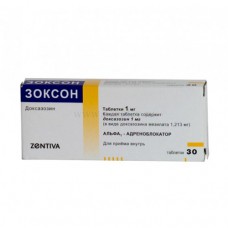Expiration date: 06/2026
pharmachologic effect
Selective blocker of ?1-adrenergic receptors.
In benign prostatic hyperplasia blocking ?1-adrenergic receptors located in the stroma and prostate capsule, and in the area of ??the bladder neck, which leads to urodynamic improvement and reduction of disease symptoms.
Application Zoxon drug with hypertension leads to a reduction of blood pressure by decreasing peripheral vascular resistance. In appointing the drug 1 time / day achieved a clinically significant hypotensive effect, which lasts for 24 hours. It is noted a gradual decrease in blood pressure and the level of maximum reduction in blood pressure is achieved in 2-6 hours after ingestion.
Zoxon has a positive effect on blood lipid profile, substantially reducing the level of triglycerides and cholesterol, thereby reducing the risk of developing coronary heart disease.
Use of the drug reduces the hypertrophy of the left ventricle of the heart contributes to inhibition of platelet aggregation and reduces the tendency to thrombosis.
Zoxon not adversely affect the overall metabolism. The drug can be used in patients with asthma, diabetes, gout, as well as in the elderly.
Pharmacokinetics
Suction
After oral administration, doxazosin is well absorbed in the gastrointestinal tract (80-90%). Simultaneous food intake slows down the absorption of the drug for 1 hour.
Cmax plasma levels achieved in 1-2 hours after administration.
Distribution
Binding to plasma proteins - 98%.
Metabolism
Doxazosin undergoes significant biotransformation in the liver to pharmacologically inactive metabolites.
Bioavailability - 69-70% (first pass metabolism).
In patients with impaired liver function, as well as when taking drugs that may alter hepatic metabolism, the process can break down the drug biotransformation.
breeding
Elimination of the drug from plasma is biphasic, with the final T1 / 2 of 22 hours. Most of the ingested doxazosin is excreted as inactive metabolites in the feces, less than 5% of the dose is excreted unchanged.
Pharmacokinetic studies in the elderly and patients with kidney disease showed no significant pharmacokinetic differences.
testimony
benign prostatic hyperplasia (Zoxon designed to treat urination disorders caused by benign prostatic hyperplasia. In patients with benign prostatic hyperplasia Zoxon can be used both in the presence of hypertension and with normal blood pressure. In patients with hypertension and benign prostatic hyperplasia Zoxon gland acts effectively on both diseases);
hypertension (Zoxon is used to treat hypertension in the event that you can not get the desired control of blood pressure, using Zoxon as monotherapy, the drug can be combined with other antihypertensive agents -. thiazide diuretics, beta-blockers, blockers of slow calcium channel inhibitors ACE).
Contraindications
age of 18 years (effectiveness and safety have been established);
Hypersensitivity to doxazosin, quinazoline derivatives, or other components of the preparation.
To apply caution in patients with impaired hepatic function, aortic and mitral stenosis, orthostatic hypotension.
Pregnancy and breast-feeding
To date, experience with doxazosin in patients with arterial hypertension during pregnancy and lactation is not sufficient. Therefore, despite the absence of teratogenic effects and embryogenic according to experimental studies, doxazosin can be administered during pregnancy and lactation only after an assessment of benefit / risk ratio.
special instructions
Precautions should be prescribed Zoxon patients with impaired liver function, especially in those cases where both are used drugs that can affect the liver. In case of deterioration of the functional state of the liver drug should be discontinued immediately.
To prevent orthostatic reactions, patients should avoid sudden and sharp transitions from a lying position to a standing position.
Drinking alcohol can increase adverse reactions.
The effect of "first dose" of the drug is especially pronounced against the background of previous diuretic therapy and dietary sodium restriction.
Before therapy Zoxon necessary to exclude malignancy of the prostate gland.
Effects on ability to drive vehicles and management mechanisms
Due to the fact that doxazosin can cause orthostatic reaction at start of treatment or during dose escalation, patients it is advisable to refrain from any potentially dangerous activities, in particular, control of truck and other vehicles and mechanisms.
Composition
1 tablet contains:
active substance: doxazosin mesylate content corresponding to 1, 2 or 4mg doxazosin
Excipients: lactose, microcrystalline cellulose pellets, microcrystalline cellulose, sodium carboxymethyl starch (type A), silica colloidal anhydrous, sodium lauryl sulfate, magnesium stearate.
Dosing and Administration
Inside 1 time / day (morning or evening), regardless of the meal. The tablets should be swallowed whole without chewing, drinking plenty of water.
In the treatment of urinary disorders caused by benign prostatic hyperplasia, hypertension, without the recommended dose is 1 mg 2-4 times / day. The maximum dose - 8 mg / day.
In hypertensive doses depending on the characteristics of the disease and the severity of the condition may vary from 1 mg / day to 16 mg / day. The maximum dose - 16 mg / day.
The initial dose is 1 mg 1 time / day before bedtime. After the first dose the patient should be in a prone position for 6-8 hours. It is required in connection with the development of "first dose phenomenon", especially pronounced on the background of the previous diuretics.
When insufficient therapeutic effect daily dose can be increased to only 2 mg 1-2 weeks of continuous treatment with the preparation. In the following 1-2 weeks the dose can be increased by 2 mg to achieve optimum therapeutic effect.
The vast majority of patients, the optimal therapeutic effect is achieved at a dose of 8 mg / day. After reaching a stable dose of a therapeutic effect is usually somewhat lower, the average therapeutic dose for maintenance therapy is usually 2-4 mg / day
The drug is used long Zoxon. The duration of treatment, the doctor determines individually.
Side effects
Arterial hypertension
Since the cardiovascular system: the most frequently observed in clinical trials, especially in the beginning of treatment, orthostatic hypotension, which in rare cases can lead to fainting; swelling. A causal relationship has not been established - bradycardia, tachycardia, palpitations, chest pain, angina pectoris, myocardial infarction, arrhythmia, cerebrovascular accident.
CNS: dizziness, headache, somnolence.
The respiratory system: rhinitis.
From the digestive system: nausea.
General reaction: asthenia, fatigue, malaise.
Benign prostatic hyperplasia
In addition the following side effects in patients with benign prostatic hyperplasia encountered side effects are the same as that in hypertensive patients.
Cardio-vascular system: decrease in blood pressure, orthostatic hypotension.
From the nervous system: insomnia, irritability, dry mouth, hypoesthesia, paraesthesia, tremor, priapism, impotence.
Respiratory system: epistaxis, dyspnoea, cough, bronchospasm.
From the digestive system: nausea, loss of appetite, dyspepsia, flatulence, abdominal pain, constipation, diarrhea, elevated liver enzymes, hepatitis, cholestasis, jaundice.
From the urinary system: dysuria, urinary incontinence, haematuria, nocturia, polyuria.
From the Endocrine: gynecomastia.
From the musculoskeletal system: muscle weakness, muscle cramps, myalgia, arthralgia.
From the senses: blurred vision, tinnitus.
From the side of hematopoiesis: leukopenia, thrombocytopenia, purpura.
With the Skin: alopecia.
General reactions: allergic reactions, skin rash, urticaria, back pain, feeling of heat (hot flushes).
Drug interactions
With the simultaneous use of the drug Zoxon and other drugs for the treatment of hypertension, the possibility of mutual gain hypotensive action.
There was no expression of negative interaction doxazosin with thiazide diuretics, beta-blockers, furosemide, calcium channel blockers of the slow, ACE inhibitors, antibiotics, oral hypoglycaemic agents, uricosuric agents and indirect anticoagulants.
In an application with inducers of microsomal oxidation in the liver may increase the effectiveness of doxazosin with inhibitors - reducing.
NSAIDs (especially indomethacin), estrogen (fluid retention) and sympathomimetic agents may reduce the antihypertensive effect of doxazosin.
Eliminating alpha adrenostimuliruyuschee effects of epinephrine, taking doxazosin may lead to tachycardia and hypotension.
Cimetidine increases AUC of doxazosin.
Overdose
Symptoms: severe hypotension, sometimes with syncope.
Treatment: stop taking the drug, the patient lay on his back with his head down and lifted his legs. If you suspect an overdose need to wash out the stomach, activated charcoal to appoint. Symptomatic therapy. Dialysis is ineffective.







